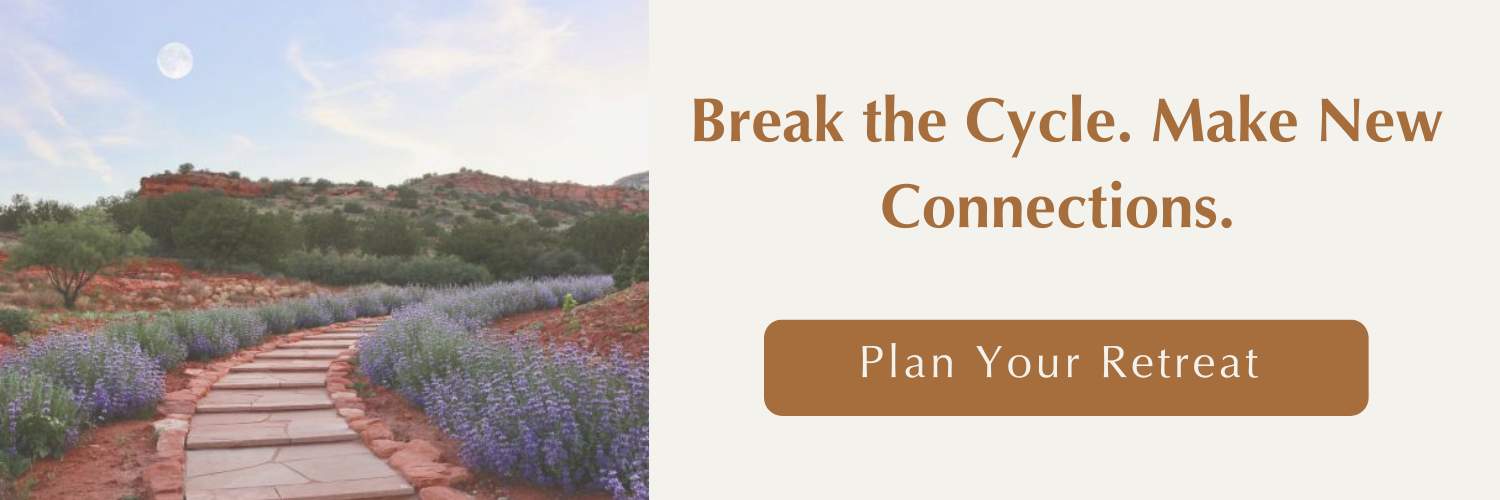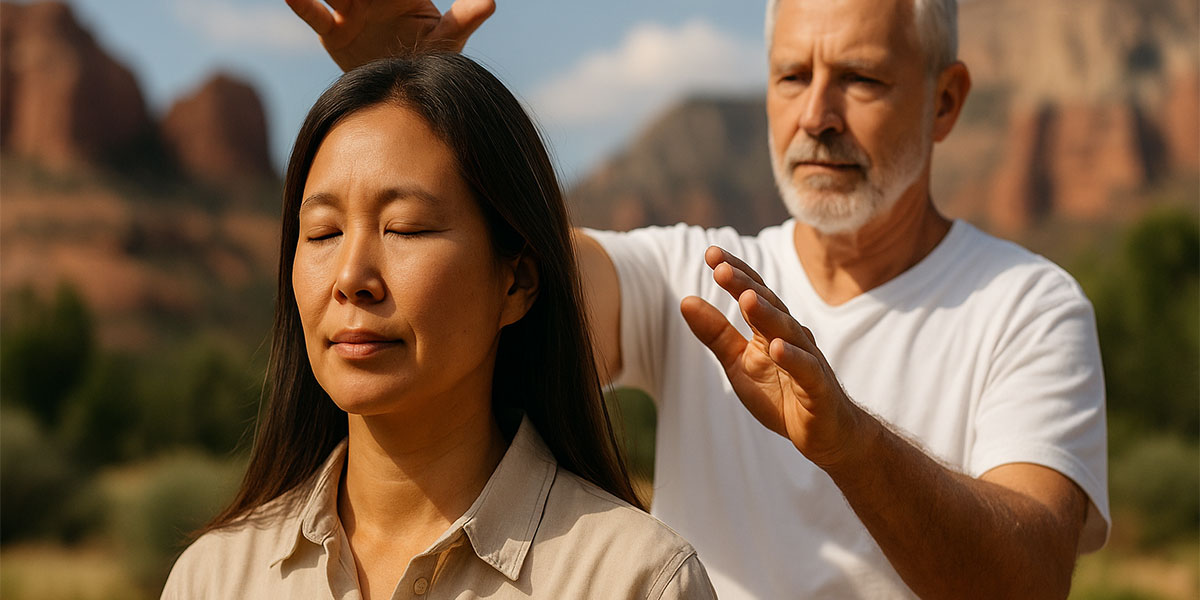How To Navigate Group Dynamics at a Retreat Using the Power of Threes
You’ve looked forward to this retreat for months. You’re enthusiastic about the opportunity to discover your true self and process emotions you haven’t had time to unpack.
But you also feel a little nervous about the other people who may be there.
Will they respect your space? Will you feel comfortable sharing your thoughts and feelings with them? Will they understand you?
In this article, we’ll discuss how to navigate group dynamics at a retreat, why it matters, and why a retreat at Sedona Mago Center for Well-Being and Retreat might be right for you.
Table of Contents
- Why Group Dynamics Matter at a Retreat
- 3 Ways To Prepare Yourself for Group Dynamics Before the Retreat
- 3 Ways To Work Through Conflicts with Compassion
- 3 Ways To Build Connection and Trust Within the Group
- 3 Ways To Integrate Group Lessons After the Retreat
- Sedona Mago Center for Well-Being and Retreat: Experience Firsthand How To Navigate Group Dynamics at a Retreat
Why Group Dynamics Matter at a Retreat
Group dynamics at a retreat can significantly impact the overall experience. While negative group dynamics may lead to hurt feelings that require conflict resolution, positive group dynamics can help foster connection, personal growth, and shared transformation.
The Power of Shared Energy
Retreats provide a unique opportunity to escape everyday distractions and routines. Often located in natural settings, a retreat environment can offer space for individuals to focus, relax, and connect.
Since a retreat is often a collective journey of exploration and growth, each participant can significantly influence the group dynamics. A retreat setting can amplify the group’s energy in either a positive or negative light.
While misaligned individual energies can lead to discomfort or conflict, cohesive energies can help:
- Foster genuine connections
- Facilitate true transformations
- Create a supportive environment conducive to growth
Common Challenges in Group Settings
Group dynamics are delicate and can be easily swayed by individual personalities
. Common challenges in group settings may include:
-
- Communication struggles: Messages can be misunderstood, leading to confusion, resentment, or misaligned goals.
- Introverts vs. extroverts: An imbalance in participation can occur when dominant personalities monopolize the conversation, leaving quieter participants feeling overshadowed and withdrawing.
- Failure to include diverse voices: Individuals may feel excluded if activities don’t account for different personalities, interests, or accessibility needs.
- Leadership conflicts: When a facilitator pushes their own agenda or fails to engage attendees, it can lead to missed insights, loss of trust, and reduced morale.
At Sedona Mago Center for Well-Being and Retreat, we offer you a place to activate your energy, enhance your self-awareness, and detoxify your body, mind, and spirit.
3 Ways To Prepare Yourself for Group Dynamics Before the Retreat
#1: Practice Mindful Communication
Mindful communication involves being aware, compassionate, and able to recognize when communication opens or closes.
Here are some examples of mindful communication:
-
- Active listening: Making eye contact, using non-verbal cues like nods, asking clarifying questions, and paraphrasing what was said to confirm understanding.
- I-statements: Clearly stating how you feel to promote understanding and offer a less hostile way to express yourself and de-escalate conflict.
- Pausing to listen: Creating environments of insight and connection to enhance both personal and communal well-being.
At Sedona Mago, we’ll support you in experiencing the stillness and peace that comes from within. Mindful communication can be achieved by balancing your inner landscape and making space for greater clarity, mindfulness, and purpose.
#2: Respect Boundaries and Differences
Respecting personal space and cultural differences may enhance harmony in a group setting by building trust and improving communication. It may also provide an individual opportunity for growth.
Here are some ways you can respect boundaries and differences in a group setting:
- Observe and adapt
- Pay attention to non-verbal cues
- Ask for permission
- Communicate openly
- Cultivate empathy
With 200 acres of property located on sacred land in the Red Rocks of Sedona, Arizona, our retreat programs can be tailored to your unique needs and are often geared toward reconnecting with oneself in a supportive group setting.
#3: Embrace the Role of Both Participant and Observer
One of the benefits of being both a participant and an observer is having a more authentic understanding than if you were to only observe from the outside.
As a participant, your engagement provides an insider’s perspective and fosters rapport with other participants. As the observer, your distance helps you collect information and perspective. You can reflect on experiences, which can help reduce emotional distress and foster greater insight.
By embracing this dual role, you can achieve a comprehensive understanding of the personal experience and its broader context.
3 Ways To Work Through Conflicts with Compassion
#1: Recognize Tension Early
Seeing early warning signs of group tension is crucial for managing conflict effectively. Here are some signs that there may be tension in a group:
- Reduced communication
- Formation of cliques or gossip
- Sarcasm or withholding information from others
- A rise in complaints or criticism
Paying attention to these signals can help address the root causes of any conflict before it escalates.
#2: Use Retreat Leaders as Guides
Sedona Mago facilitators are trained to navigate group energy and resolve conflict. We believe in turning challenging situations into opportunities for growth and improvement.
Guests are supported through guided meditation, life coaching, and the practice of releasing tension by reconnecting with their natural healing power.
As a group, your retreat leaders can support you in releasing what no longer serves you, allowing room for new growth and practices that will propel you forward.
#3: Shift From “Me” to “We”
Moving the focus from individual needs to collective well-being is part of a transformative mindset essential for personal growth and a more profound sense of purpose and belonging. This mindset is often implemented in a work setting to build strong relationships and a more motivated, productive group work culture.
Research suggests that nourishing positive relationships at work is a powerful way to improve workplace satisfaction. Group retreat activities help people better understand each other’s communication styles.
Spending time together in a different environment and engaging in thought-provoking activities can yield many positive outcomes.
Corporate retreats can provide practical tools for enhancing workplace connectivity by:
- Improving workplace culture
- Elevating employee well-being
- Sparking creativity and perspective
At Sedona Mago, corporate retreats can grow connections between staff members. We offer group and corporate event hosting, holistic retreats, and healing services to reconnect with nature, yourself, and your coworkers. Contact us today to begin a supportive wellness retreat for your employees.
3 Ways To Build Connection and Trust Within the Group
#1: The Power of Shared Rituals
By intentionally participating in meaningful shared moments, individuals and groups can strengthen their bonds and well-being.
One study finds that when individuals ritually meet in emotionally charged interactions, these interactions hold society together by generating essential social emotions, social ties, and group solidarity.
Some collective practices that can foster unity at Sedona Mago include:
- Meditation circle
- Nature walks
- Mindful Qigong
- Vortex tours
- Wellness classes
#2: Honoring Vulnerability
It can be intimidating to let someone see us as we truly are, but when our vulnerability comes into the open, it may create space for growth and change.
Surrounded by a group of supportive individuals who share common goals, you may feel at ease letting down your walls, participating openly, and beginning to live intentionally in the present moment.
Research shows that story sharing is an effective strategy for promoting and fostering standard connections that lead to positive relationships, boosting self-esteem and instilling courage in others.
You are not alone; each person is trying to figure out how to navigate group dynamics at a retreat. Every individual brings a unique story of separate experiences. It’s pivotal to foster empathy and respect others’ pace when revealing their journeys.
#3: Celebrating Differences as Strengths
Collaborative learning environments that celebrate differences cultivate essential interpersonal skills such as communication, empathy, and teamwork. Uniting people with varying personalities and experiences can significantly improve group outcomes by:
- Promoting empathy and understanding
- Fostering collaboration
- Creating healthy debate and constructive questioning
- Encouraging innovation and imaginative solutions
- Improving adaptability
A group with diverse backgrounds offers a range of viewpoints that can help maximize your transformation. Celebrating and embracing others’ differences can provide you with the toolkit to experience a robust, well-rounded self-discovery.
3 Ways To Integrate Group Lessons After the Retreat
#1: Reflection Practices
After a retreat, focused reflection can help ensure that the clarity and renewed purpose you experienced don’t fade after you return to your routine. It’s a valuable step for integrating the lessons and insights you gained at the retreat into your daily life.
Some ways for you to practice reflection after your retreat might include:
- Journaling or revisiting notes
- Going on nature walks
- Engaging in art, music, or writing
- Setting daily intentions
- Meditation
#2: Bringing Group Wisdom Into Daily Life
The daily grind can be challenging, whether it’s balancing a busy schedule or feeling disconnected. Applying the knowledge you gained at the retreat to your everyday life can help. Here are some ways to practice what you learned:
-
- Set a mindful daily routine: Start each day with meditation, turn transitions into mindful moments, and create a small space in your home for reflection.
- Practice compassionate listening: Stay present and engaged when listening to friends, family, or colleagues. Listen to understand and validate their feelings before asking questions.
- Cultivate patience: Treat challenges as opportunities, remembering that progress is better than perfection. Set healthy boundaries for yourself at home and work, and practice observing others’ thoughts and emotions without judgment.
#3: Staying Connected Beyond the Retreat
Some groups may form lasting bonds after the retreat. Common ways group members stay connected include:
- Online communities
- Casual friendships
- Follow-up meetings or retreats
Sedona Mago encourages ongoing connection because it can provide a supportive, accountable network that helps you continue your practice.
Sedona Mago Center for Well-Being and Retreat: Experience Firsthand How To Navigate Group Dynamics at a Retreat
At Sedona Mago Center for Well-Being and Retreat, we’ll guide you toward healing, releasing any self-imposed limitations, and awakening your full potential. Our healing services blend ancient wisdom with modern techniques to rejuvenate your body and mind.
Some of our holistic services include:
- Chakra Healing and Balancing
- Crystal Healing
- Aura Reading
- Sound Healing
- Spiritual Healing
Our retreat programs can be tailored to your unique needs and goals. Whether you’re seeking physical renewal, emotional healing, or spiritual growth, Sedona Mago offers programs, settings, and services to support your transformative experiences. Here are some of the programs we offer:
- Sedona Meditation Weekend
- Finding True Self
- The Sedona Wellness Retreat
- Revitalizing Detox Retreat
- And more
Join us on a journey where insight and intuition can come to life, revealing new perspectives and inspirations. Contact us today to learn more about our retreat programs and packages, as well as our phenomenal group services.
Recent Posts





